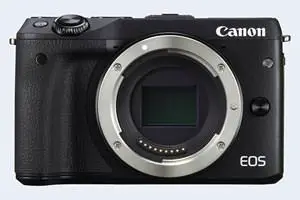Canon M3 vs Sony HX400V
The Canon EOS M3 and the Sony Cyber-shot DSC-HX400V are two digital cameras that were announced, respectively, in February 2015 and February 2014. The M3 is a mirrorless interchangeable lens camera, while the HX400V is a fixed lens compact. The cameras are based on an APS-C (M3) and a 1/2.3-inch (HX400V) sensor. The Canon has a resolution of 24 megapixels, whereas the Sony provides 20.2 MP.
Below is an overview of the main specs of the two cameras as a starting point for the comparison.

Check M3 offers at
ebay.com

Check HX400V offers at
ebay.com
Going beyond this snapshot of core features and characteristics, what are the differences between the Canon EOS M3 and the Sony Cyber-shot DSC-HX400V? Which one should you buy? Read on to find out how these two cameras compare with respect to their body size, their imaging sensors, their shooting features, their input-output connections, and their reception by expert reviewers.
Body comparison
An illustration of the physical size and weight of the Canon M3 and the Sony HX400V is provided in the side-by-side display below. The two cameras are presented according to their relative size. Three consecutive views from the front, the top, and the rear side are shown. All width, height and depth measures are rounded to the nearest millimeter.
The M3 can be obtained in two different colors (black, white), while the HX400V is only available in black.
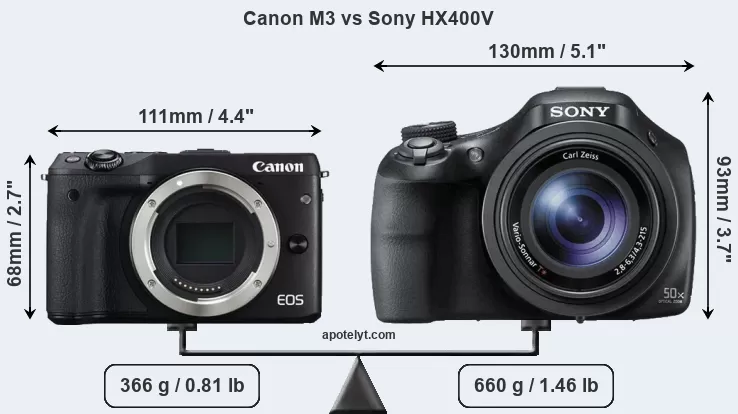
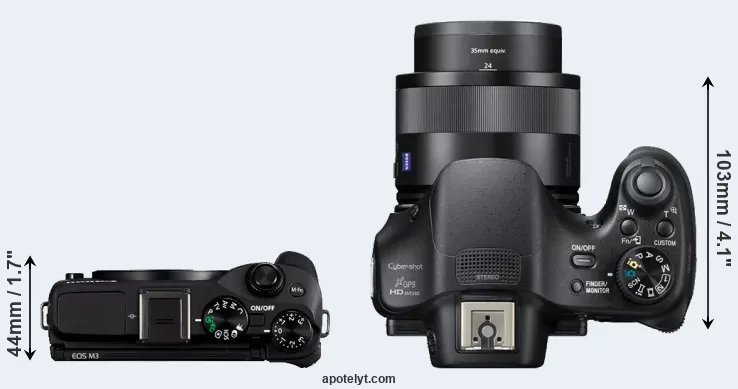
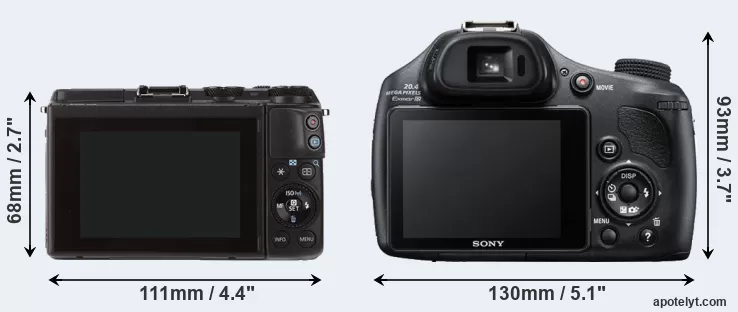
If the front view area (width x height) of the cameras is taken as an aggregate measure of their size, the Sony HX400V is considerably larger (60 percent) than the Canon M3. In this context, it is worth noting that neither the M3 nor the HX400V are weather-sealed.
The above size and weight comparisons are to some extent incomplete and possibly misleading, as the HX400V has a lens built in, whereas the M3 is an interchangeable lens camera that requires a separate lens. Attaching the latter will add extra weight and bulk to the setup.
Concerning battery life, the M3 gets 250 shots out of its Canon LP-E17 battery, while the HX400V can take 300 images on a single charge of its Sony NP-BX1 power pack.
The adjacent table lists the principal physical characteristics of the two cameras alongside a wider set of alternatives. If you want to switch the focus of the display and review another camera pair, you can move across to the CAM-parator tool and choose from the broad selection of possible camera comparisons there.

| Camera Model |
Camera Width |
Camera Height |
Camera Depth |
Camera Weight |
Battery Life |
Weather Sealing |
Camera Launch |
Launch Price (USD) |
Street Price |
||
|---|---|---|---|---|---|---|---|---|---|---|---|
| 1. | Canon M3 | 111 mm | 68 mm | 44 mm | 366 g | 250 | n | Feb 2015 | 679 | ebay.com | |
| 2. | Sony HX400V | 130 mm | 93 mm | 103 mm | 660 g | 300 | n | Feb 2014 | 499 | ebay.com | |
| 3. | Canon G5 X | 112 mm | 76 mm | 44 mm | 353 g | 210 | n | Oct 2015 | 799 | ebay.com | |
| 4. | Canon G7 X | 103 mm | 60 mm | 40 mm | 304 g | 210 | n | Sep 2014 | 699 | ebay.com | |
| 5. | Canon M | 109 mm | 66 mm | 32 mm | 298 g | 230 | n | Jul 2012 | 599 | ebay.com | |
| 6. | Canon M5 | 116 mm | 89 mm | 61 mm | 427 g | 295 | n | Sep 2016 | 979 | ebay.com | |
| 7. | Canon M6 | 112 mm | 68 mm | 45 mm | 390 g | 295 | n | Feb 2017 | 779 | ebay.com | |
| 8. | Canon M50 | 116 mm | 88 mm | 59 mm | 390 g | 235 | n | Feb 2018 | 779 | ebay.com | |
| 9. | Canon M50 Mark II | 116 mm | 88 mm | 59 mm | 387 g | 305 | n | Oct 2020 | 599 | ebay.com | |
| 10. | Canon M100 | 108 mm | 67 mm | 35 mm | 302 g | 295 | n | Aug 2017 | 499 | ebay.com | |
| 11. | Canon SX60 | 128 mm | 93 mm | 114 mm | 650 g | 340 | n | Sep 2014 | 549 | ebay.com | |
| 12. | Canon T6i | 132 mm | 101 mm | 78 mm | 555 g | 440 | n | Feb 2015 | 749 | ebay.com | |
| 13. | Canon T6s | 132 mm | 101 mm | 78 mm | 565 g | 440 | n | Feb 2015 | 649 | ebay.com | |
| 14. | Sony H300 | 128 mm | 89 mm | 92 mm | 590 g | 350 | n | Feb 2014 | 219 | ebay.com | |
| 15. | Sony H400 | 130 mm | 95 mm | 122 mm | 628 g | 300 | n | Feb 2014 | 319 | ebay.com | |
| 16. | Sony HX90V | 102 mm | 58 mm | 36 mm | 245 g | 360 | n | Apr 2015 | 429 | ebay.com | |
| 17. | Sony HX350 | 130 mm | 93 mm | 103 mm | 652 g | 300 | n | Dec 2016 | 449 | ebay.com | |
| Note: Measurements and pricing do not include easily detachable parts, such as add-on or interchangeable lenses or optional viewfinders. | |||||||||||
Any camera decision will naturally be influenced heavily by the price. The listed launch prices provide an indication of the market segment that the manufacturer of the cameras have been targeting. The HX400V was launched at a lower price than the M3, despite having a lens built in. Normally, street prices remain initially close to the MSRP, but after a couple of months, the first discounts appear. Later in the product cycle and, in particular, when the replacement model is about to appear, further discounting and stock clearance sales often push the camera price considerably down. Then, after the new model is out, very good deals can frequently be found on the pre-owned market.
Sensor comparison
The size of the imaging sensor is a crucial determinant of image quality. A large sensor will generally have larger individual pixels that offer better low-light sensitivity, provide wider dynamic range, and have richer color-depth than smaller pixels in a sensor of the same technological generation. Furthermore, a large sensor camera will give the photographer more possibilities to use shallow depth-of-field in order to isolate a subject from the background. On the downside, larger sensors tend to be associated with larger, more expensive camera bodies and lenses.
Of the two cameras under consideration, the Canon M3 features an APS-C sensor and the Sony HX400V a 1/2.3-inch sensor. The sensor area in the HX400V is 92 percent smaller. As a result of these sensor size differences, the cameras have a format factor of, respectively, 1.6 and 5.6. The sensor in the M3 has a native 3:2 aspect ratio, while the one in the HX400V offers a 4:3 aspect.
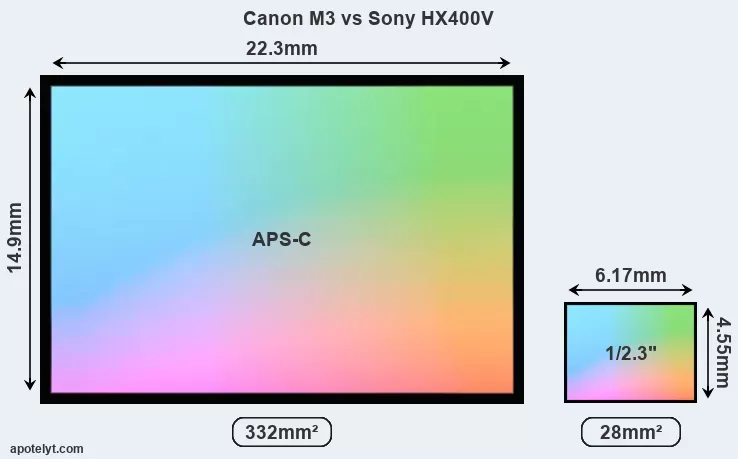
With 24MP, the M3 offers a higher resolution than the HX400V (20.2MP), but the M3 nevertheless has larger individual pixels (pixel pitch of 3.72μm versus 1.18μm for the HX400V) due to its larger sensor. Moreover, the M3 is a somewhat more recent model (by 11 months) than the HX400V, and its sensor might have benefitted from technological advances during this time that further enhance the light gathering capacity of its pixels. Coming back to sensor resolution, it should be mentioned that the HX400V has no anti-alias filter installed, so that it can capture all the detail its sensor resolves.
The resolution advantage of the Canon M3 implies greater flexibility for cropping images or the possibility to print larger pictures. The maximum print size of the M3 for good quality output (200 dots per inch) amounts to 30 x 20 inches or 76.2 x 50.8 cm, for very good quality (250 dpi) 24 x 16 inches or 61 x 40.6 cm, and for excellent quality (300 dpi) 20 x 13.3 inches or 50.8 x 33.9 cm. The corresponding values for the Sony HX400V are 25.9 x 19.4 inches or 65.8 x 49.4 cm for good quality, 20.7 x 15.6 inches or 52.7 x 39.5 cm for very good quality, and 17.3 x 13 inches or 43.9 x 32.9 cm for excellent quality prints.
The M3 has on-sensor phase detect pixels, which results in fast and reliable autofocus acquisition even during live view operation.
The Canon EOS M3 has a native sensitivity range from ISO 100 to ISO 12800, which can be extended to ISO 100-25600. The corresponding ISO settings for the Sony Cyber-shot DSC-HX400V are ISO 80 to ISO 3200, with the possibility to increase the ISO range to 80-12800.
In terms of underlying technology, the M3 is build around a CMOS sensor, while the HX400V uses a BSI-CMOS imager. Both cameras use a Bayer filter for capturing RGB colors on a square grid of photosensors. This arrangement is found in most digital cameras.
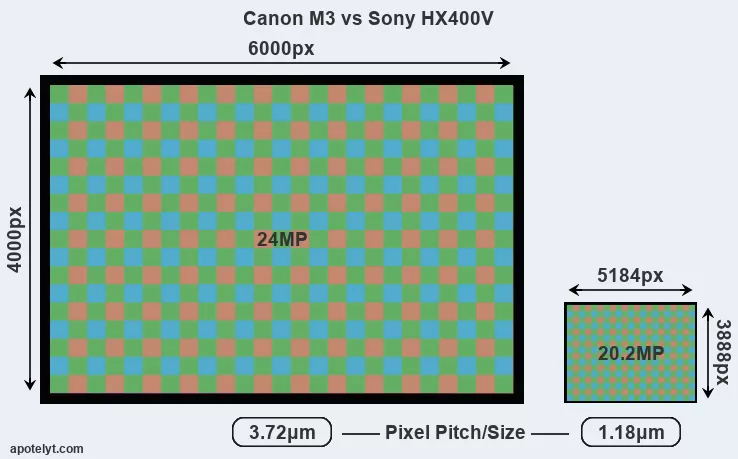
Consistent information on actual sensor performance is available from DXO Mark for many cameras. This service determines an overall sensor rating, as well as sub-scores for low-light sensitivity ("DXO Sports"), dynamic range ("DXO Landscape"), and color depth ("DXO Portrait"). The adjacent table reports on the physical sensor characteristics and the outcomes of the DXO sensor quality tests for a sample of comparator-cameras.

| Camera Model |
Sensor Class |
Resolution (MP) |
Horiz. Pixels |
Vert. Pixels |
Video Format |
DXO Portrait |
DXO Landscape |
DXO Sports |
DXO Overall |
||
|---|---|---|---|---|---|---|---|---|---|---|---|
| 1. | Canon M3 | APS-C | 24.0 | 6000 | 4000 | 1080/30p | 22.8 | 11.8 | 1169 | 72 | |
| 2. | Sony HX400V | 1/2.3 | 20.2 | 5184 | 3888 | 1080/60p | 20.1 | 11.4 | 629 | 45 | |
| 3. | Canon G5 X | 1-inch | 20.0 | 5472 | 3648 | 1080/60p | 21.4 | 12.3 | 471 | 62 | |
| 4. | Canon G7 X | 1-inch | 20.0 | 5472 | 3648 | 1080/60p | 23.0 | 12.7 | 556 | 71 | |
| 5. | Canon M | APS-C | 17.9 | 5184 | 3456 | 1080/30p | 22.1 | 11.2 | 827 | 65 | |
| 6. | Canon M5 | APS-C | 24.0 | 6000 | 4000 | 1080/60p | 23.4 | 12.4 | 1262 | 77 | |
| 7. | Canon M6 | APS-C | 24.0 | 6000 | 4000 | 1080/60p | 23.4 | 12.6 | 1317 | 78 | |
| 8. | Canon M50 | APS-C | 24.0 | 6000 | 4000 | 4K/24p | 23.8 | 13.3 | 1684 | 81 | |
| 9. | Canon M50 Mark II | APS-C | 24.0 | 6000 | 4000 | 4K/24p | 24.0 | 13.6 | 1939 | 83 | |
| 10. | Canon M100 | APS-C | 24.0 | 6000 | 4000 | 1080/60p | 23.5 | 12.9 | 1272 | 78 | |
| 11. | Canon SX60 | 1/2.3 | 14.2 | 4608 | 3072 | 1080/60p | 19.2 | 10.8 | 127 | 39 | |
| 12. | Canon T6i | APS-C | 24.0 | 6000 | 4000 | 1080/30p | 22.7 | 12.0 | 919 | 71 | |
| 13. | Canon T6s | APS-C | 24.0 | 6000 | 4000 | 1080/30p | 22.6 | 12.0 | 915 | 70 | |
| 14. | Sony H300 | 1/2.3 | 19.9 | 5152 | 3864 | 720/30p | 20.1 | 11.4 | 630 | 45 | |
| 15. | Sony H400 | 1/2.3 | 19.9 | 5152 | 3864 | 720/30p | 20.1 | 11.4 | 630 | 45 | |
| 16. | Sony HX90V | 1/2.3 | 18.0 | 4896 | 3672 | 1080/60p | 20.2 | 11.6 | 738 | 47 | |
| 17. | Sony HX350 | 1/2.3 | 19.9 | 5152 | 3864 | 1080/60p | 20.5 | 11.9 | 896 | 49 | |
| Note: DXO values in italics represent estimates based on sensor size and age. | |||||||||||
Many modern cameras are not only capable of taking still images, but can also record movies. Both cameras under consideration have a sensor with sufficiently fast read-out times for moving pictures, but the HX400V provides a faster frame rate than the M3. It can shoot movie footage at 1080/60p, while the Canon is limited to 1080/30p.
Feature comparison
Apart from body and sensor, cameras can and do differ across a range of features. For example, the HX400V has an electronic viewfinder (210k dots), which can be very helpful when shooting in bright sunlight. In contrast, the M3 relies on live view and the rear LCD for framing. That said, the M3 can be equipped with an optional viewfinder – the EVF-DC1. The table below summarizes some of the other core capabilities of the Canon M3 and Sony HX400V in connection with corresponding information for a sample of similar cameras.

| Camera Model |
Viewfinder (Type or 000 dots) |
Control Panel (yes/no) |
LCD Specifications (inch/000 dots) |
LCD Attach- ment |
Touch Screen (yes/no) |
Max Shutter Speed * |
Max Shutter Flaps * |
Built-in Flash (yes/no) |
Built-in Image Stab |
||
|---|---|---|---|---|---|---|---|---|---|---|---|
| 1. | Canon M3 | optional | n | 3.0 / 1040 | tilting | Y | 1/4000s | 4.2/s | Y | n | |
| 2. | Sony HX400V | 210 | n | 3.0 / 921 | tilting | n | 1/4000s | 10.0/s | Y | Y | |
| 3. | Canon G5 X | 2360 | n | 3.0 / 1040 | swivel | Y | 1/2000s | 5.9/s | Y | Y | |
| 4. | Canon G7 X | none | n | 3.0 / 1040 | tilting | Y | 1/2000s | 6.5/s | Y | Y | |
| 5. | Canon M | none | n | 3.0 / 1040 | fixed | Y | 1/4000s | 4.3/s | n | n | |
| 6. | Canon M5 | 2360 | n | 3.2 / 1620 | tilting | Y | 1/4000s | 9.0/s | Y | n | |
| 7. | Canon M6 | optional | n | 3.0 / 1040 | tilting | Y | 1/4000s | 9.0/s | Y | n | |
| 8. | Canon M50 | 2360 | n | 3.0 / 1040 | swivel | Y | 1/4000s | 10.0/s | Y | n | |
| 9. | Canon M50 Mark II | 2360 | n | 3.0 / 1040 | swivel | Y | 1/4000s | 10.0/s | Y | n | |
| 10. | Canon M100 | none | n | 3.0 / 1040 | tilting | Y | 1/4000s | 6.1/s | Y | n | |
| 11. | Canon SX60 | 922 | n | 3.0 / 922 | swivel | n | 1/2000s | 6.4/s | Y | Y | |
| 12. | Canon T6i | optical | n | 3.0 / 1040 | swivel | Y | 1/4000s | 5.0/s | Y | n | |
| 13. | Canon T6s | optical | Y | 3.0 / 1040 | swivel | Y | 1/4000s | 5.0/s | Y | n | |
| 14. | Sony H300 | none | n | 3.0 / 460 | fixed | n | 1/1500s | 0.8/s | Y | Y | |
| 15. | Sony H400 | 210 | n | 3.0 / 460 | fixed | n | 1/2000s | 0.7/s | Y | Y | |
| 16. | Sony HX90V | 638 | n | 3.0 / 921 | tilting | n | 1/2000s | 10.0/s | Y | Y | |
| 17. | Sony HX350 | 202 | n | 3.0 / 922 | tilting | n | 1/4000s | 10.0/s | Y | Y | |
| Note: *) Information refers to the mechanical shutter, unless the camera only has an electronic one. | |||||||||||
One differentiating feature between the two cameras concerns the touch sensitivity of the rear screen. The M3 has a touchscreen, while the HX400V has a conventional panel. Touch control can be particularly helpful, for example, for setting the focus point.
The M3 has an articulated LCD that can be turned to be front-facing. This characteristic will be appreciated by vloggers and photographers who are interested in snapping selfies. In contrast, the HX400V does not have a selfie-screen.The M3 writes its imaging data to SDXC cards, while the HX400V uses SDXC or Memory Stick PRO Duo cards. The M3 supports UHS-I cards (Ultra High Speed data transfer of up to 104 MB/s), while the HX400V cannot take advantage of Ultra High Speed SD cards.
Connectivity comparison
For some imaging applications, the extent to which a camera can communicate with its environment can be an important aspect in the camera decision process. The table below provides an overview of the connectivity of the Canon EOS M3 and Sony Cyber-shot DSC-HX400V and, in particular, the interfaces the cameras (and selected comparators) provide for accessory control and data transfer.

| Camera Model |
Hotshoe Port |
Internal Mic / Speaker |
Microphone Port |
Headphone Port |
HDMI Port |
USB Port |
WiFi Support |
NFC Support |
Bluetooth Support |
||
|---|---|---|---|---|---|---|---|---|---|---|---|
| 1. | Canon M3 | Y | stereo / mono | Y | - | mini | 2.0 | Y | Y | - | |
| 2. | Sony HX400V | Y | stereo / mono | - | - | micro | 2.0 | Y | Y | - | |
| 3. | Canon G5 X | Y | stereo / mono | - | - | mini | 2.0 | Y | Y | - | |
| 4. | Canon G7 X | - | stereo / mono | - | - | micro | 2.0 | Y | Y | - | |
| 5. | Canon M | Y | stereo / mono | Y | - | mini | 2.0 | - | - | - | |
| 6. | Canon M5 | Y | stereo / mono | Y | - | mini | 2.0 | Y | Y | Y | |
| 7. | Canon M6 | Y | stereo / mono | Y | - | mini | 2.0 | Y | Y | Y | |
| 8. | Canon M50 | Y | stereo / mono | Y | - | micro | 2.0 | Y | - | Y | |
| 9. | Canon M50 Mark II | Y | stereo / mono | Y | - | micro | 2.0 | Y | - | Y | |
| 10. | Canon M100 | - | stereo / mono | - | - | micro | 2.0 | Y | Y | Y | |
| 11. | Canon SX60 | Y | stereo / mono | Y | - | mini | 2.0 | Y | Y | - | |
| 12. | Canon T6i | Y | stereo / mono | Y | - | mini | 2.0 | Y | Y | - | |
| 13. | Canon T6s | Y | stereo / mono | Y | - | mini | 2.0 | Y | Y | - | |
| 14. | Sony H300 | - | mono / mono | - | - | micro | 2.0 | Y | - | - | |
| 15. | Sony H400 | - | mono / mono | - | - | micro | 2.0 | Y | - | - | |
| 16. | Sony HX90V | - | stereo / mono | - | - | micro | 2.0 | Y | Y | - | |
| 17. | Sony HX350 | - | stereo / mono | - | - | micro | 2.0 | - | - | - |
It is notable that the M3 has a microphone port, which is missing on the HX400V. Such an external microphone input can help to substantially improve the quality of audio recordings when a good external microphone is used.
Travel and landscape photographers will find it useful that the HX400V has an internal geolocalization sensor and can record GPS coordinates in its EXIF data.
Both the M3 and the HX400V have been discontinued, but can regularly be found used on ebay. The M3 was replaced by the Canon M6, while the HX400V does not have a direct successor. Further information on the features and operation of the M3 and HX400V can be found, respectively, in the Canon M3 Manual (free pdf) or the online Sony HX400V Manual.
Review summary
So what conclusions can be drawn? Is the Canon M3 better than the Sony HX400V or vice versa? The listing below highlights the relative strengths of the two models.

Advantages of the Canon EOS M3:
- More detail: Offers more megapixels (24 vs 20.2MP) with a 11% higher linear resolution.
- Better moiré control: Has an anti-alias filter to avoid artificial patterns to appear in images.
- Better image quality: Features a larger and more technologically advanced imaging sensor.
- Richer colors: The sensor size advantage translates into images with better, more accurate colors.
- More dynamic range: Larger sensor captures a wider spectrum of light and dark details.
- Better low-light sensitivity: Larger sensor produces good images even in poorly lit environments.
- Better live-view autofocus: Features on-sensor phase-detection for more confident autofocus.
- Better sound: Can connect to an external microphone for higher quality sound recording.
- More detailed LCD: Has a higher resolution rear screen (1040k vs 921k dots).
- Fewer buttons to press: Is equipped with a touch-sensitive rear screen to facilitate handling.
- More selfie-friendly: Has an articulated screen that can be turned to be front-facing.
- More flexible: Accepts interchangeable lenses, so that lens characteristics can be altered.
- More compact: Is smaller (111x68mm vs 130x93mm) and thus needs less room in the bag.
- Faster buffer clearing: Has an SD card interface that supports the UHS-I standard.
- More modern: Is somewhat more recent (announced 11 months after the HX400V).

Reasons to prefer the Sony Cyber-shot DSC-HX400V:
- Maximized detail: Lacks an anti-alias filter to exploit the sensor's full resolution potential.
- Better video: Provides higher movie framerates (1080/60p versus 1080/30p).
- Easier framing: Has an electronic viewfinder for image composition and settings control.
- Faster burst: Shoots at higher frequency (10 vs 4.2 flaps/sec) to capture the decisive moment.
- Ready to shoot: Has an integrated lens, whereas the M3 necessitates an extra lens.
- Longer lasting: Gets more shots (300 versus 250) out of a single battery charge.
- Sharper images: Has stabilization technology built-in to reduce the impact of hand-shake.
- Easier geotagging: Features an internal GPS sensor to log localization data.
- More affordable: Was introduced at a lower price, despite coming with a built-in lens.
- More heavily discounted: Has been on the market for longer (launched in February 2014).
If the number of relative strengths (bullet points above) is taken as a guide, the M3 is the clear winner of the match-up (15 : 10 points). However, the relevance of individual strengths will vary across photographers, so that you might want to apply your own weighing scheme to the summary points when reflecting and deciding on a new camera. A professional wedding photographer will view the differences between cameras in a way that diverges from the perspective of a travel photog, and a person interested in cityscapes has distinct needs from a macro shooter. Hence, the decision which camera is best and worth buying is often a very personal one.
How about other alternatives? Do the specifications of the Canon M3 and the Sony HX400V place the cameras among the top in their class? Find out in the latest Best Mirrorless Interchangeable Lens Camera and Best Superzoom Camera listings whether the two cameras rank among the cream of the crop.
In any case, while the comparison of technical specifications can provide a useful overview of the capabilities of different cameras, it remains incomplete and does no justice, for example, to the way the M3 or the HX400V perform in practice. User reviews that are available, for instance, at amazon can sometimes shed light on these issues, but such feedback is all too often partial, inconsistent, and inaccurate.
Expert reviews
This is why hands-on reviews by experts are important. The following table reports the overall ratings of the cameras as published by some of the major camera review sites (amateurphotographer [AP], cameralabs [CL], digitalcameraworld [DCW], dpreview [DPR], ephotozine [EPZ], photographyblog [PB]). As can be seen, the professional reviewers agree in many cases on the quality of different cameras, but sometimes their assessments diverge, reinforcing the earlier point that a camera decision is often a very personal choice.

| Camera Model |
AP score |
CL score |
DCW score |
DPR score |
EPZ score |
PB score |
Camera Launch |
Launch Price (USD) |
Street Price |
||
|---|---|---|---|---|---|---|---|---|---|---|---|
| 1. | Canon M3 | 4/5 | o | .. | 75/100 | 4.5/5 | 4/5 | Feb 2015 | 679 | ebay.com | |
| 2. | Sony HX400V | 4/5 | + + | .. | .. | 4/5 | 4/5 | Feb 2014 | 499 | ebay.com | |
| 3. | Canon G5 X | 5/5 | + + | .. | 78/100 | 4.5/5 | 4.5/5 | Oct 2015 | 799 | ebay.com | |
| 4. | Canon G7 X | 4/5 | + + | .. | 77/100 | 4.5/5 | 4.5/5 | Sep 2014 | 699 | ebay.com | |
| 5. | Canon M | 3/5 | + | .. | .. | 4/5 | 4/5 | Jul 2012 | 599 | ebay.com | |
| 6. | Canon M5 | 4/5 | + | 4/5 | 82/100 | 4/5 | 4/5 | Sep 2016 | 979 | ebay.com | |
| 7. | Canon M6 | .. | .. | .. | 80/100 | 4/5 | 4/5 | Feb 2017 | 779 | ebay.com | |
| 8. | Canon M50 | .. | + | 4/5 | 79/100 | .. | 3.5/5 | Feb 2018 | 779 | ebay.com | |
| 9. | Canon M50 Mark II | 4/5 | .. | 4/5 | .. | 4.5/5 | 3.5/5 | Oct 2020 | 599 | ebay.com | |
| 10. | Canon M100 | 3/5 | + | .. | .. | 4/5 | 3.5/5 | Aug 2017 | 499 | ebay.com | |
| 11. | Canon SX60 | 3/5 | + + | .. | 75/100 | 4/5 | 4.5/5 | Sep 2014 | 549 | ebay.com | |
| 12. | Canon T6i | 5/5 | .. | .. | 75/100 | 4.5/5 | 4.5/5 | Feb 2015 | 749 | ebay.com | |
| 13. | Canon T6s | 5/5 | + | .. | 77/100 | 4.5/5 | 4.5/5 | Feb 2015 | 649 | ebay.com | |
| 14. | Sony H300 | .. | + | .. | .. | 4.5/5 | 4/5 | Feb 2014 | 219 | ebay.com | |
| 15. | Sony H400 | .. | o | .. | .. | 3.5/5 | 3.5/5 | Feb 2014 | 319 | ebay.com | |
| 16. | Sony HX90V | 4/5 | + + | .. | .. | 4/5 | 4.5/5 | Apr 2015 | 429 | ebay.com | |
| 17. | Sony HX350 | .. | .. | .. | .. | .. | 4/5 | Dec 2016 | 449 | ebay.com | |
| Note: (+ +) highly recommended; (+) recommended; (o) reviewed; (..) not available. | |||||||||||
The review scores listed above should be treated with care, though. The assessments were made in relation to similar cameras of the same technological generation. Hence, a score should always be seen in the context of the camera's market launch date and its price, and comparing ratings of very distinct cameras or ones that are far apart in terms of their release date have little meaning. Also, kindly note that some of the listed sites have over time developped their review approaches and their reporting style.

Check M3 offers at
ebay.com

Check HX400V offers at
ebay.com
Other camera comparisons
Did this review help to inform your camera decision process? If you would like to see a different side-by-side camera review, just use the search menu below. There is also a set of direct links to comparison reviews that other users of the CAM-parator app explored.
Specifications: Canon M3 vs Sony HX400V
Below is a side-by-side comparison of the specs of the two cameras to facilitate a quick review of their differences and common features.
| Camera Model | Canon M3 | Sony HX400V |
|---|---|---|
| Camera Type | Mirrorless system camera | Fixed lens compact camera |
| Camera Lens | Canon EF-M mount lenses | 24-1200mm f/2.8-6.3 |
| Launch Date | February 2015 | February 2014 |
| Launch Price | USD 679 | USD 499 |
| Sensor Specs | Canon M3 | Sony HX400V |
| Sensor Technology | CMOS | BSI-CMOS |
| Sensor Format | APS-C Sensor | 1/2.3" Sensor |
| Sensor Size | 22.3 x 14.9 mm | 6.17 x 4.55 mm |
| Sensor Area | 332.27 mm2 | 28.0735 mm2 |
| Sensor Diagonal | 26.8 mm | 7.7 mm |
| Crop Factor | 1.6x | 5.6x |
| Sensor Resolution | 24 Megapixels | 20.2 Megapixels |
| Image Resolution | 6000 x 4000 pixels | 5184 x 3888 pixels |
| Pixel Pitch | 3.72 μm | 1.18 μm |
| Pixel Density | 7.22 MP/cm2 | 71.80 MP/cm2 |
| Moiré control | Anti-Alias filter | no AA filter |
| Movie Capability | 1080/30p Video | 1080/60p Video |
| ISO Setting | 100 - 12,800 ISO | 80 - 3,200 ISO |
| ISO Boost | 100 - 25,600 ISO | 80 - 12,800 ISO |
| Image Processor | DIGIC 6 | BIONZ X |
| DXO Sensor Quality (score) | 72 | .. |
| DXO Color Depth (bits) | 22.8 | .. |
| DXO Dynamic Range (EV) | 11.8 | .. |
| DXO Low Light (ISO) | 1169 | .. |
| Screen Specs | Canon M3 | Sony HX400V |
| Viewfinder Type | Viewfinder optional | Electronic viewfinder |
| Viewfinder Field of View | 100% | |
| Viewfinder Resolution | 210k dots | |
| LCD Framing | Live View | Live View |
| Rear LCD Size | 3.0inch | 3.0inch |
| LCD Resolution | 1040k dots | 921k dots |
| LCD Attachment | Tilting screen | Tilting screen |
| Touch Input | Touchscreen | no Touchscreen |
| Shooting Specs | Canon M3 | Sony HX400V |
| Focus System | On-Sensor Phase-detect | Contrast-detect AF |
| Manual Focusing Aid | Focus Peaking | no Peaking Feature |
| Continuous Shooting | 4.2 shutter flaps/s | 10 shutter flaps/s |
| Fill Flash | Built-in Flash | Built-in Flash |
| Storage Medium | SDXC cards | MS or SDXC cards |
| Single or Dual Card Slots | Single card slot | Single card slot |
| UHS card support | UHS-I | no |
| Connectivity Specs | Canon M3 | Sony HX400V |
| External Flash | Hotshoe | Hotshoe |
| USB Connector | USB 2.0 | USB 2.0 |
| HDMI Port | mini HDMI | micro HDMI |
| Microphone Port | External MIC port | no MIC socket |
| Wifi Support | Wifi built-in | Wifi built-in |
| Near-Field Communication | NFC built-in | NFC built-in |
| Geotagging | no internal GPS | GPS built-in |
| Body Specs | Canon M3 | Sony HX400V |
| Battery Type | Canon LP-E17 | Sony NP-BX1 |
| Battery Life (CIPA) | 250 shots per charge | 300 shots per charge |
| Body Dimensions |
111 x 68 x 44 mm (4.4 x 2.7 x 1.7 in) |
130 x 93 x 103 mm (5.1 x 3.7 x 4.1 in) |
| Camera Weight | 366 g (12.9 oz) | 660 g (23.3 oz) |

Check M3 offers at
ebay.com

Check HX400V offers at
ebay.com
Did you notice an error on this page? If so, please get in touch, so that we can correct the information.
